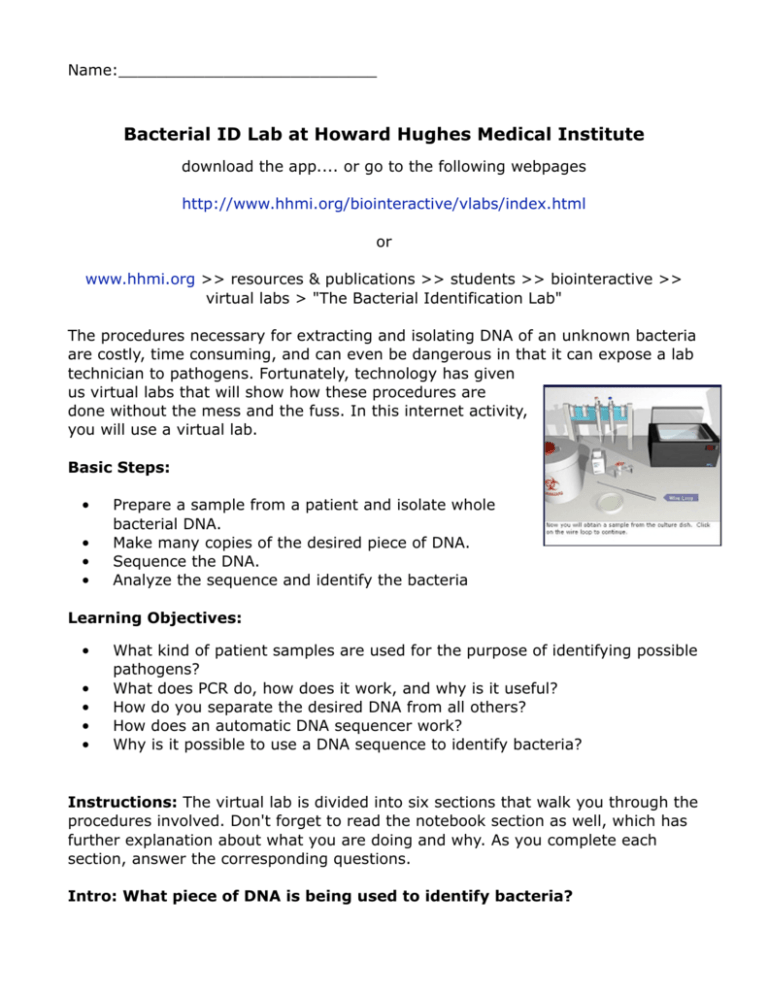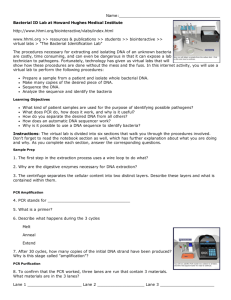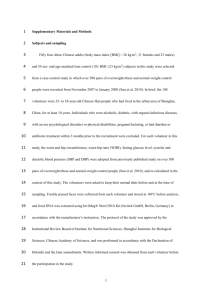Bacterial BLAST
advertisement

Name:___________________________ Bacterial ID Lab at Howard Hughes Medical Institute download the app.... or go to the following webpages http://www.hhmi.org/biointeractive/vlabs/index.html or www.hhmi.org >> resources & publications >> students >> biointeractive >> virtual labs > "The Bacterial Identification Lab" The procedures necessary for extracting and isolating DNA of an unknown bacteria are costly, time consuming, and can even be dangerous in that it can expose a lab technician to pathogens. Fortunately, technology has given us virtual labs that will show how these procedures are done without the mess and the fuss. In this internet activity, you will use a virtual lab. Basic Steps: • • • • Prepare a sample from a patient and isolate whole bacterial DNA. Make many copies of the desired piece of DNA. Sequence the DNA. Analyze the sequence and identify the bacteria Learning Objectives: • • • • • What kind of patient samples are used for the purpose of identifying possible pathogens? What does PCR do, how does it work, and why is it useful? How do you separate the desired DNA from all others? How does an automatic DNA sequencer work? Why is it possible to use a DNA sequence to identify bacteria? Instructions: The virtual lab is divided into six sections that walk you through the procedures involved. Don't forget to read the notebook section as well, which has further explanation about what you are doing and why. As you complete each section, answer the corresponding questions. Intro: What piece of DNA is being used to identify bacteria? Sample Prep 1. The first step in the extraction process uses a wire loop to do what? 2. Why are the digestive enzymes necessary for DNA extraction? 3. Why must you then head the micro-centrifuge tube? 4. The centrifuge separates the cellular content into two distinct layers. Describe these layers and what is contained within them. PCR Amplification 5. PCR stands for ________________________________ 6. What is found in the PCR Master Mix? 7. What is a primer? (see link) 8. Describe what happens during the 3 PCR stages Melt Anneal Extend 9. After 30 cycles, how many copies of the initial DNA strand have been produced? Why is this called "amplification"? PCR Purification 8. To confirm that the PCR worked, three lanes are run that contain 3 materials. What materials are in the 3 lanes? Lane 1 __________________________ Lane 2 ______________________ Lane 3 _______________________ 9. What is the overall purpose of the purification stage? Sequencing Prep 10. How are dideoxynucleotides used in sequencing? (learn about cycle sequencing link) 11. Why are multiple primers used? 12. Describe the “sequencing brew” that you added your purified PCR to. 11. The purpose of the second PCR is not to create identical copies like the first PCR you ran. What is the purpose of this second PCR? DNA Sequencing 12. What is the final PCR product, the stuff contained in your 12 tubes? 13. What is gel electrophoresis? 14. Why does DNA move through the capillary tube towards the syringe? Sequence Analysis 14. What is BLAST? (see The science behind sequencing link) 15. What does it mean for a region of DNA to be “conserved?” 16. The higher the score the ______________ the match (see learn more about BLAST link) 17. What does a low E value mean? 18. What is the identity of the bacteria in your sample? Follow the steps listed on the page and be patient, statistically aligning the sequences can take time. Sample A (lymph node) _______________________ Sample B (stool sample)_______________________ Sample C (urine sample) _______________________ Sample D (blood sample) _______________________ Sample E (sputum sample) _______________________ Sample F (stool sample) _______________________









